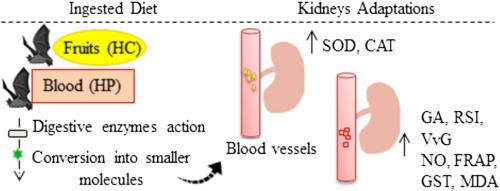Our official English website, www.x-mol.net, welcomes your feedback! (Note: you will need to create a separate account there.)
Aspects regarding renal morphophysiology of fruit-eating and vampire bats
Zoology ( IF 2 ) Pub Date : 2021-02-01 , DOI: 10.1016/j.zool.2020.125861 Bárbara Silva Linhares 1 , Susana Puga Ribeiro 2 , Renata Maria Pereira de Freitas 1 , Luciano Carlos Heringer Porcaro Puga 3 , Sirlene Souza Rodrigues Sartori 1 , Mariella Bontempo Freitas 1
Zoology ( IF 2 ) Pub Date : 2021-02-01 , DOI: 10.1016/j.zool.2020.125861 Bárbara Silva Linhares 1 , Susana Puga Ribeiro 2 , Renata Maria Pereira de Freitas 1 , Luciano Carlos Heringer Porcaro Puga 3 , Sirlene Souza Rodrigues Sartori 1 , Mariella Bontempo Freitas 1
Affiliation

|
Bats have adapted to many different feeding habits, which are known to induce morphophysiological adaptations in several tissues, especially those particularly involved with absorption, metabolism and excretion. The common vampire bat (Desmodus rotundus) has a very unique diet (blood), which, among other challenges, seems to pose a risk to their kidneys, due to the increased nitrogen excretion imposed by their remarkably high protein meal. Fruit-eating bats (Artibeus lituratus) consume a high carbohydrate diet and may be taken as a suitable species for this dietary comparative study. Here we aimed at investigating the renal morphology and stereology, kidneys antioxidant capacity, and plasma antidiuretic hormone (ADH) concentrations in adult fruit-eating and vampire bats. Sixteen animals were captured and used in this study, being 8 adult males from each species. Our results showed higher morphological standards of glomerular area, volumetric density of glomeruli, and renal somatic index for vampire bats, as well as higher reactive species of oxygen (ROS) production, such as nitric oxide (NO), higher plasma iron reduction ability (FRAP), higher activity of the antioxidant enzyme glutathione-S-transferase (GST) and a higher malondialdehyde production (MDA) in vampires' kidneys, compared to the fruit-eating species. The activities of the antioxidant enzymes superoxide dismutase (SOD) and catalase (CAT) were higher in fruit-eating bats. Plasma ADH concentrations were not different between species. Taken together, the renal morphophysiology conditions presented by vampire bats might be associated with a high demand for nitrogenous products excretion imposed by protein and iron overload. These features may play an important role on preventing protein-overload nephropathy, allowing vampires to survive under such a unique diet.
中文翻译:

食果蝙蝠和吸血蝙蝠的肾脏形态生理学方面
蝙蝠已经适应了许多不同的饮食习惯,众所周知,这些习惯会在多种组织中诱导形态生理适应,尤其是那些特别涉及吸收、代谢和排泄的组织。常见的吸血蝙蝠(Desmodus rotundus)有一种非常独特的饮食(血液),除其他挑战外,这似乎对它们的肾脏构成了风险,因为它们非常高的蛋白质膳食增加了氮的排泄。吃水果的蝙蝠 (Artibeus lituratus) 消耗高碳水化合物饮食,可以作为该饮食比较研究的合适物种。在这里,我们旨在调查成年食果蝙蝠和吸血蝙蝠的肾脏形态和体视学、肾脏抗氧化能力和血浆抗利尿激素 (ADH) 浓度。在这项研究中捕获并使用了 16 只动物,每个物种有8只成年雄性。我们的研究结果表明,吸血蝙蝠的肾小球面积、肾小球体积密度和肾体细胞指数具有更高的形态学标准,以及更高的活性氧 (ROS) 产生,如一氧化氮 (NO),更高的血浆铁还原能力。 FRAP)、抗氧化酶谷胱甘肽-S-转移酶 (GST) 的活性更高,吸血鬼肾脏中的丙二醛产量 (MDA) 比吃水果的物种更高。吃水果的蝙蝠的抗氧化酶超氧化物歧化酶 (SOD) 和过氧化氢酶 (CAT) 的活性较高。血浆 ADH 浓度在物种之间没有差异。综合起来,吸血蝙蝠表现出的肾脏形态生理状况可能与蛋白质和铁过载导致的对含氮产物排泄的高需求有关。这些特征可能在预防蛋白质过载肾病方面发挥重要作用,使吸血鬼能够在这种独特的饮食下生存。
更新日期:2021-02-01
中文翻译:

食果蝙蝠和吸血蝙蝠的肾脏形态生理学方面
蝙蝠已经适应了许多不同的饮食习惯,众所周知,这些习惯会在多种组织中诱导形态生理适应,尤其是那些特别涉及吸收、代谢和排泄的组织。常见的吸血蝙蝠(Desmodus rotundus)有一种非常独特的饮食(血液),除其他挑战外,这似乎对它们的肾脏构成了风险,因为它们非常高的蛋白质膳食增加了氮的排泄。吃水果的蝙蝠 (Artibeus lituratus) 消耗高碳水化合物饮食,可以作为该饮食比较研究的合适物种。在这里,我们旨在调查成年食果蝙蝠和吸血蝙蝠的肾脏形态和体视学、肾脏抗氧化能力和血浆抗利尿激素 (ADH) 浓度。在这项研究中捕获并使用了 16 只动物,每个物种有8只成年雄性。我们的研究结果表明,吸血蝙蝠的肾小球面积、肾小球体积密度和肾体细胞指数具有更高的形态学标准,以及更高的活性氧 (ROS) 产生,如一氧化氮 (NO),更高的血浆铁还原能力。 FRAP)、抗氧化酶谷胱甘肽-S-转移酶 (GST) 的活性更高,吸血鬼肾脏中的丙二醛产量 (MDA) 比吃水果的物种更高。吃水果的蝙蝠的抗氧化酶超氧化物歧化酶 (SOD) 和过氧化氢酶 (CAT) 的活性较高。血浆 ADH 浓度在物种之间没有差异。综合起来,吸血蝙蝠表现出的肾脏形态生理状况可能与蛋白质和铁过载导致的对含氮产物排泄的高需求有关。这些特征可能在预防蛋白质过载肾病方面发挥重要作用,使吸血鬼能够在这种独特的饮食下生存。



























 京公网安备 11010802027423号
京公网安备 11010802027423号